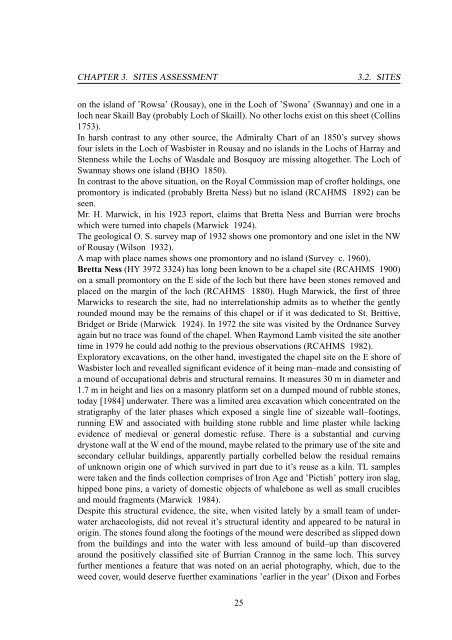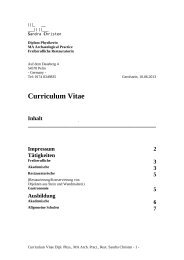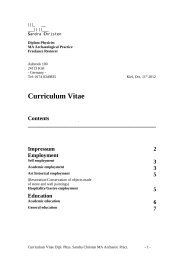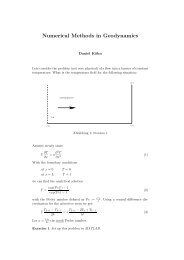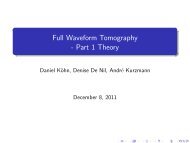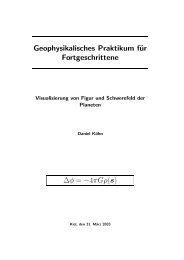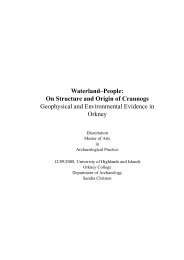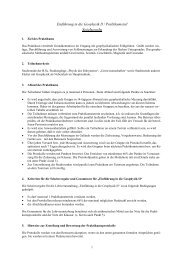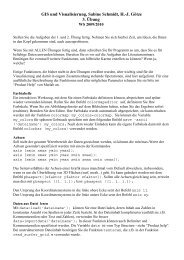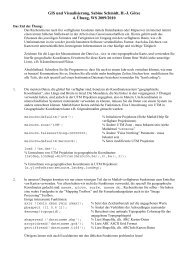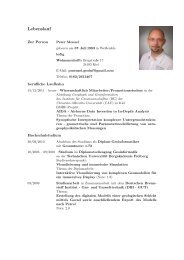Waterland–People: On Structure and Origin of Crannogs ...
Waterland–People: On Structure and Origin of Crannogs ...
Waterland–People: On Structure and Origin of Crannogs ...
You also want an ePaper? Increase the reach of your titles
YUMPU automatically turns print PDFs into web optimized ePapers that Google loves.
CHAPTER 3. SITES ASSESSMENT<br />
3.2. SITES<br />
on the isl<strong>and</strong> <strong>of</strong> ’Rowsa’ (Rousay), one in the Loch <strong>of</strong> ’Swona’ (Swannay) <strong>and</strong> one in a<br />
loch near Skaill Bay (probably Loch <strong>of</strong> Skaill). No other lochs exist on this sheet (Collins<br />
1753).<br />
In harsh contrast to any other source, the Admiralty Chart <strong>of</strong> an 1850’s survey shows<br />
four islets in the Loch <strong>of</strong> Wasbister in Rousay <strong>and</strong> no isl<strong>and</strong>s in the Lochs <strong>of</strong> Harray <strong>and</strong><br />
Stenness while the Lochs <strong>of</strong> Wasdale <strong>and</strong> Bosquoy are missing altogether. The Loch <strong>of</strong><br />
Swannay shows one isl<strong>and</strong> (BHO 1850).<br />
In contrast to the above situation, on the Royal Commission map <strong>of</strong> cr<strong>of</strong>ter holdings, one<br />
promontory is indicated (probably Bretta Ness) but no isl<strong>and</strong> (RCAHMS 1892) can be<br />
seen.<br />
Mr. H. Marwick, in his 1923 report, claims that Bretta Ness <strong>and</strong> Burrian were brochs<br />
which were turned into chapels (Marwick 1924).<br />
The geological O. S. survey map <strong>of</strong> 1932 shows one promontory <strong>and</strong> one islet in the NW<br />
<strong>of</strong> Rousay (Wilson 1932).<br />
A map with place names shows one promontory <strong>and</strong> no isl<strong>and</strong> (Survey c. 1960).<br />
Bretta Ness (HY 3972 3324) has long been known to be a chapel site (RCAHMS 1900)<br />
on a small promontory on the E side <strong>of</strong> the loch but there have been stones removed <strong>and</strong><br />
placed on the margin <strong>of</strong> the loch (RCAHMS 1880). Hugh Marwick, the first <strong>of</strong> three<br />
Marwicks to research the site, had no interrelationship admits as to whether the gently<br />
rounded mound may be the remains <strong>of</strong> this chapel or if it was dedicated to St. Brittive,<br />
Bridget or Bride (Marwick 1924). In 1972 the site was visited by the Ordnance Survey<br />
again but no trace was found <strong>of</strong> the chapel. When Raymond Lamb visited the site another<br />
time in 1979 he could add nothig to the previous observations (RCAHMS 1982).<br />
Exploratory excavations, on the other h<strong>and</strong>, investigated the chapel site on the E shore <strong>of</strong><br />
Wasbister loch <strong>and</strong> revealled significant evidence <strong>of</strong> it being man–made <strong>and</strong> consisting <strong>of</strong><br />
a mound <strong>of</strong> occupational debris <strong>and</strong> structural remains. It measures 30 m in diameter <strong>and</strong><br />
1.7 m in height <strong>and</strong> lies on a masonry platform set on a dumped mound <strong>of</strong> rubble stones,<br />
today [1984] underwater. There was a limited area excavation which concentrated on the<br />
stratigraphy <strong>of</strong> the later phases which exposed a single line <strong>of</strong> sizeable wall–footings,<br />
running EW <strong>and</strong> associated with building stone rubble <strong>and</strong> lime plaster while lacking<br />
evidence <strong>of</strong> medieval or general domestic refuse. There is a substantial <strong>and</strong> curving<br />
drystone wall at the W end <strong>of</strong> the mound, maybe related to the primary use <strong>of</strong> the site <strong>and</strong><br />
secondary cellular buildings, apparently partially corbelled below the residual remains<br />
<strong>of</strong> unknown origin one <strong>of</strong> which survived in part due to it’s reuse as a kiln. TL samples<br />
were taken <strong>and</strong> the finds collection comprises <strong>of</strong> Iron Age <strong>and</strong> ’Pictish’ pottery iron slag,<br />
hipped bone pins, a variety <strong>of</strong> domestic objects <strong>of</strong> whalebone as well as small crucibles<br />
<strong>and</strong> mould fragments (Marwick 1984).<br />
Despite this structural evidence, the site, when visited lately by a small team <strong>of</strong> underwater<br />
archaeologists, did not reveal it’s structural identity <strong>and</strong> appeared to be natural in<br />
origin. The stones found along the footings <strong>of</strong> the mound were described as slipped down<br />
from the buildings <strong>and</strong> into the water with less amound <strong>of</strong> build–up than discovered<br />
around the positively classified site <strong>of</strong> Burrian Crannog in the same loch. This survey<br />
further mentiones a feature that was noted on an aerial photography, which, due to the<br />
weed cover, would deserve fuerther examinations ’earlier in the year’ (Dixon <strong>and</strong> Forbes<br />
25


